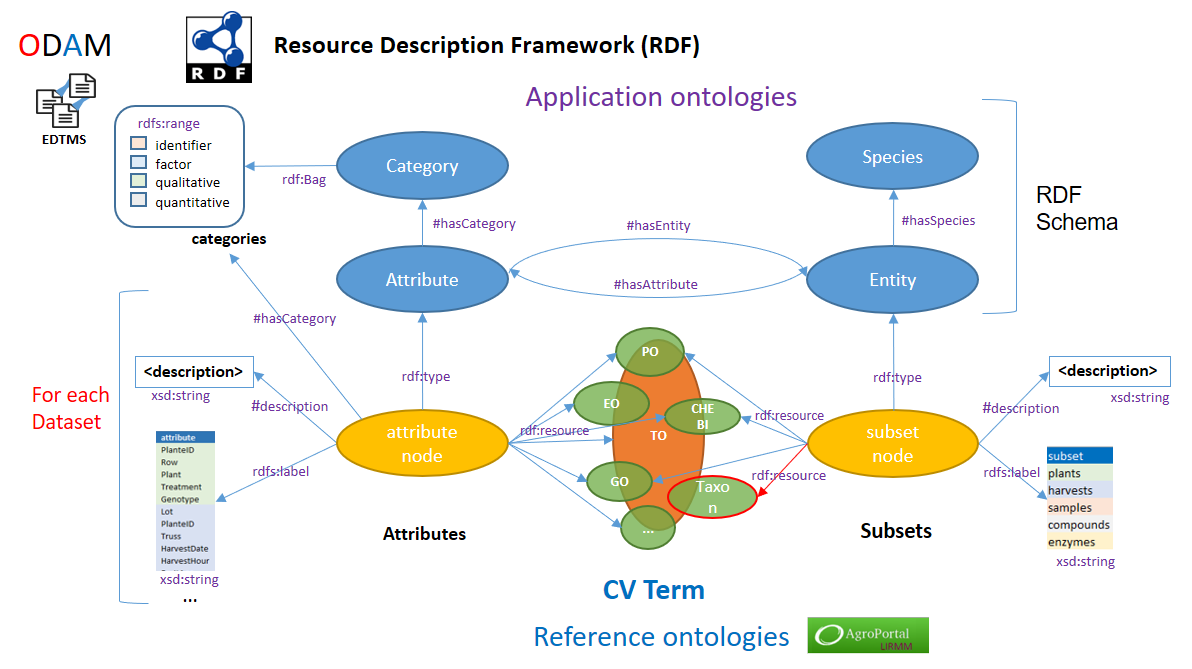TODO
ODAM: Development roadmap¶
Data extraction¶
-
Extension of the Rodam package
- Data exploitation only based on the datapackage.json file - an equivalent of the datapackage-r package for ODAM datapackage.
- It will facilitate the reuse of the data provided with this structure by installing a single R package.
- Development of a python package equivalent to Rodam
-
Build a lightweight interface (jQuery/Bootstrap) for
- Data extraction - equivalent to Web API functions
- Generation of the datapackage.json file with additional metadata
- e.g. description of the dataset, choice of license, keywords, sources, ...
Data annotation¶
Development carried out in interaction with the FooSIN project
-
Build a lightweight interface (jQuery/Bootstrap) for
- Attribute annotations with terms selected from ontologies.
- The choice of ontologies will be based on predefined sets according to the domain under consideration. For example, in the domain of plants, a set of ontologies will be predefined according to AgroPortal.
- The chosen solution will be greatly inspired by the RightField project, the Swate tool or the annotation module of the MeRyB database
-
Automatic proposals for annotation
- based on the annotation module of AgroPortal through its API.
Linked Data¶
Development carried out in interaction with the FooSIN project
-
Build an ontology-based model to describe the structure of tabular and relational data, primarily focused on concepts of data entity1, data attributes2, and categories of variables (identifier3, factor4, quantitative5, qualitative6), as shown below :
- See Make your data great again : How to ensure that open data works for research - Towards Linked Data

-
Make a proposal to convert a ODAM datapackage to JSON-LD and then to RDF.
- Mainly based on the ontology defined at point 1.
- the Tbox will be based on the AgroPortal ontologies as a Proof of Concept.
-
A data entity is an object in a data model. Data is typically designed by breaking things down into their smallest parts that are useful for representing data relationships. For example, a plant can generate a list of samples. Each sample can be associated with several types of analytical variables. All three objects: plant, sample and type of analytical variables are considered data entities. ↩
-
Data attributes are characteristics of a data object. From data science view, they are the features of a data entity. They exist most often as a column in a data table. ↩
-
Identifiers precisely reference within the experiment each of the elements belonging to the same observation entity forming a coherent observation unit. For example, each plant, each sample has its own identifier, ↩
-
A factor of an experiment is a controlled independent variable; a variable whose levels are set by the experimenter. Treatments (control vs. stress), genotype (WT vs. mutant), the course of time (development stages) or even tissues, are typical factors of experiments. ↩
-
Quantitative data are values that describe a measurable quantity, in the form of numbers that can be calculated. ↩
-
Qualitative data describe qualities or characteristics. They answer questions such as "what type" or "what category". These values ↩